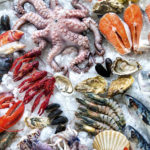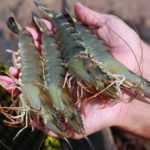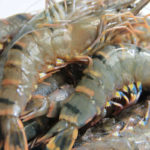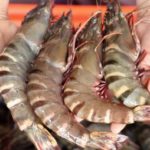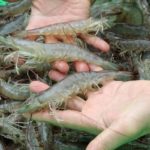Pumping impurities into shrimp is a fraudulent commercial practice. Many people add impurities to shrimp to increase their volume, size, alter their texture, or deceive the perception of freshness of the product… To avoid buying shrimp that has been pumped with impurities, the Ho Chi Minh City Food Safety Authority has identified the following ways to distinguish:
Choose shrimp based on visual observation
Observe the overall appearance of the shrimp from head to tail, paying attention to the head, body, and tail of the shrimp.
– Body: Shrimp with impurities will have a swollen, bloated abdomen segment one or three segments (counting from head to tail), and it will feel scaly when touched.
– The third segment will be stretched, the body of the shrimp will be tense, even unnaturally round.
– Tail: Signs of shrimp pumped with impurities at the tail are relatively easy to recognize, with raised tail spines and spread-out tail flaps.

Choose shrimp after peeling
– Peel the head and carapace: Hold the shrimp with the head facing downward, use your hand to peel the shrimp’s head to expose the meaty part. Use a sharp knife to carefully flip and scrape off the mass (hepatopancreas) to reveal the empty head cavity. Observe if there is any suspicious fluid in the head cavity. Natural shrimp will not have any fluid.
– Peel the shrimp’s body: After peeling the shrimp’s body, pay attention to the external appearance of the shrimp, especially at the third, fourth, and sixth meat segments, to see if there are signs of unnatural swelling in the muscle segments. In shrimp pumped with impurities, the swollen muscle segments can be clearly seen. For heavily pumped shrimp, use a needle to puncture the swollen muscle segment on the abdomen or back, and squeezing it can reveal the expelled impurities.

In addition to profit, many retailers have another trick, regardless of means, they use agar powder to inject into freshwater prawns to make them appear fresh, firm, and beautiful. Then they marinate them in ice and distribute them in styrofoam containers for consumption.
The most commonly pumped shrimp is the green tiger shrimp. Traders inject agar powder into each shrimp. The shrimp pumping solution mainly consists of starches such as agar, Aar, CMC (a stabilizing agent used to control the viscosity of seafood)… which is usually cooked or mixed with water into a viscous solution. Then, they use a syringe to inject directly into the head, body, and tail of the shrimp. To maintain the appearance of freshness for a longer period, many traders also use hangeo, matchstick splints, urea… to marinate the shrimp.

So how to choose good shrimp?
Just observe the tail of the shrimp carefully, and if you are attentive, you can distinguish between shrimp pumped with impurities and normal shrimp.
Shrimp pumped with powder
– The tails of shrimp pumped with powder are usually curled.
– Abnormally plump body, to the point where the meat segments on the body are almost stretched, especially the segment between the head and body.
– The shrimp’s head is stiff and straight, swollen and bloated, while a natural shrimp has a flat and soft belly.
– When cooked, it releases a lot of water, and the shrimp meat shrinks. The taste of the meat is bland compared to normal shrimp.
– When cooked and peeled, you can easily see a layer of agar between the meat and the shrimp shell. Especially in the head area, below the swimmerets.
– When cooked, it releases a lot of water. When the cooked shrimp is peeled, you can easily see a layer of agar between the meat and the shrimp shell, especially in the head area, below the swimmerets.
– The shrimp meat will shrink and become firmer. It has a blander taste than usual.
– It is difficult to distinguish the color of shrimp pumped with impurities and clean shrimp.
Shrimp injected with urea
– Shrimp injected with urea or chemicals will swell with water together with the meat and shell.
– The shell of the shrimp is tense, the joints between the shell segments are stretched, the head spikes are raised, and the tail flaps are spread out, and the color is pale.
– The head and body of the shrimp that has been injected can be easily separated from each other.
– When cooked, it releases a lot of water, and you may smell a strange odor. The shrimp meat shrinks, and the taste is not as delicious.
Choosing fresh shrimp
– Normally, live shrimp should have a curved body, a soft body, and a cupped tail.
– The safest way to buy fresh live shrimp is to buy shrimp that are still moving, with a shiny shell, intact antennae, and legs.
– Choose shrimp with shiny, fresh-looking shells, with the meat firmly attached to the shell.
– For frozen or cooked shrimp, lift the shrimp up, hold the head and tail to pull the shrimp straight out. If the joints between the shrimp segments are tightly packed, it means the shrimp is fresh, but if these joints are spread out, it means the shrimp has been frozen for too long.
– Iron shrimp should not be selected if they have turned pink, as they are no longer fresh and tasty.
– Horseshoe crab should be purchased live, with pink-white shells and black eyes.
– Coral shrimp should not be chosen if they are turning dark pink because that means they are old and no longer fresh.
According to Giadinh.net

























